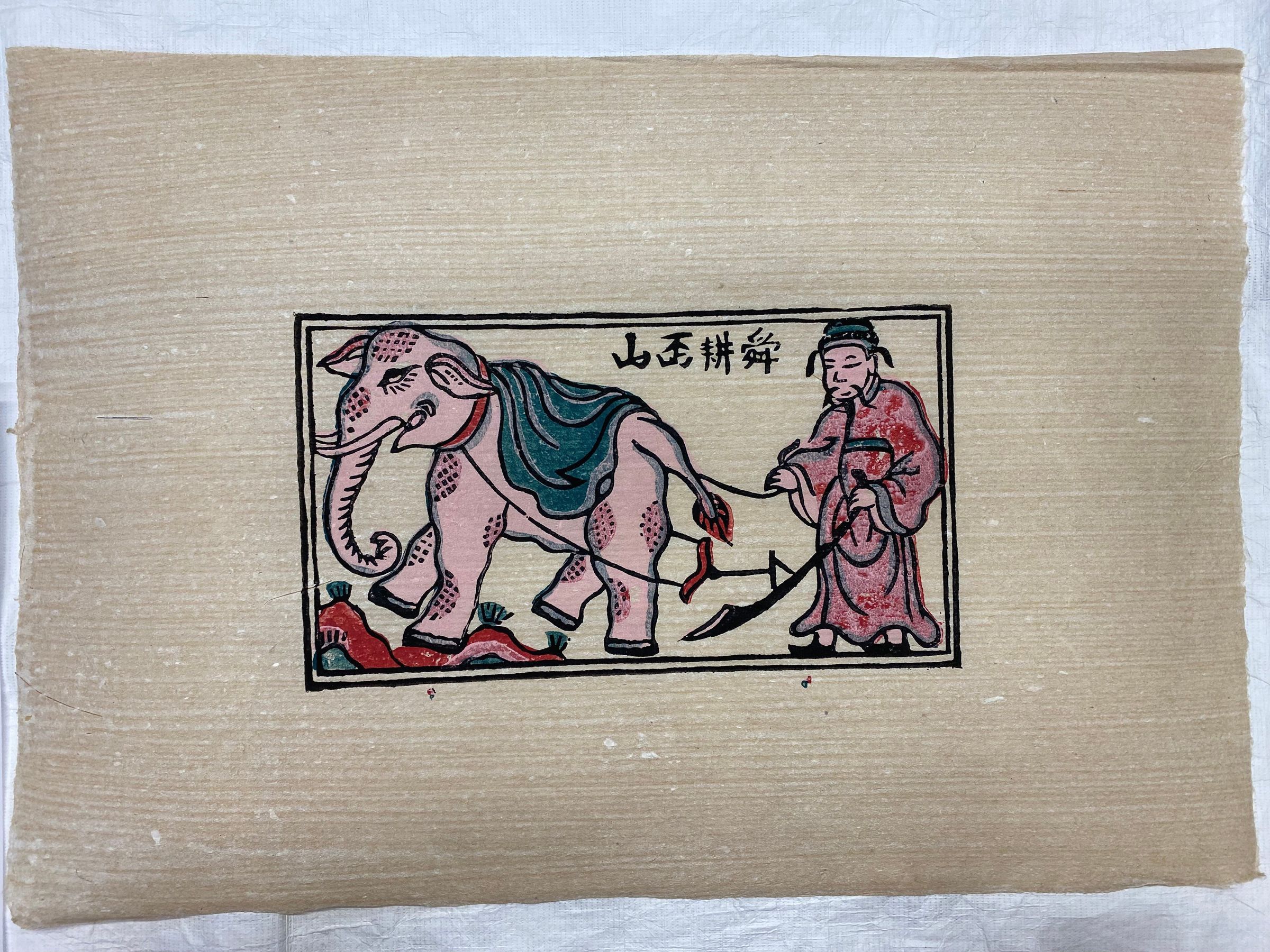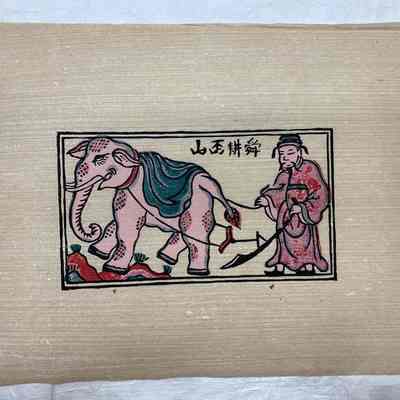Name/Title
Ðông Hồ Portfolio Con Voi Kéo Cày (The Elephant Pulls the Plow)Entry/Object ID
2019.P-G.078HDescription
Traditional Vietnamese folk woodblock print on plant fibrous paper that horizontally depicts a male figure following behind an elephant with a plough secured to the elephant being guided by the male figure. Vietnamese characters are to the right of the male figure's head across the top of the printed image.Context
This painting might be associated with the Vietnamese proverb: “Con voi kéo cày không phải vì nó muốn, mà vì nó phải." which translate to "The elephant pulls the plow not because it wants to, but because it has to." This saying emphasizes the idea of fulfilling obligations or duties out of necessity, even if it's not something one desires or enjoys. It speaks to the idea of responsibility and the sacrifices made out of obligation, much like the elephant, which does the heavy work of farming not out of choice, but because it is used for this purpose.
*Characters have yet to be translated
From insert in boxset about series, directly transcribed:
A Brief Overview of "Ðông Hồ" Folk Paintings:
The "Dong Ho" folk paintings have been around for nearly 500 years. The themes of these paintings were inspired by everyday life and created by artisans' observations and experiences.
The main themes include:
Congratulatory paintings, which reflect the common wishes of people: a happy family, longevity, wealth, and prosperity, as seen in paintings such as Phú Quý (Wealth and Nobility), Vinh Hoa (Glory), Gà Đàn (Hen and Chicks), Lợn Đàn (Pigs).
Paintings depicting festivals and traditional activities, such as wrestling contests, drum carrying, buffalo fighting, as well as daily life scenes like đánh ghen (a fight between women over a man), hứng dừa (picking coconuts), thầy đồ cóc (the frog teacher), đám cưới chuột (a mouse wedding), and folklore stories such as Trê Cóc Kiện Nhau (Catfish and Frog Suing Each Other), Đinh Bộ Lĩnh (founding emperor of the short-lived Đinh dynasty), and Bà Triệu (legendary Vietnamese heroine).
Over many generations, artisans creatively used available local materials to craft these artworks.
Initially, the images were carved onto wood, usually wood from the thị tree, thừng mực wood, or vàng tâm wood. These carvings were then printed onto dó paper, which had been coated with a special resin. Dó paper is handmade from the bark of the dó tree, while the resin is made from the shells of dead mollusks, cleaned, crushed, and mixed with rice paste. The mixture was applied to the paper with a brush made from dry pine leaves, creating the texture that gives the painting life.
The artisans used only a few natural materials to create the colors: red from clay, green from tràm leaves or copper rust, white from diệp powder, yellow from the hoè tree flowers, and black from ash made from bamboo leaves or rice straw.
The patterns were carefully printed and harmoniously arranged, creating a unique identity. In the rich collection of Vietnamese folk art, the "Dong Ho" paintings stand out as a distinct form of expression, originating from the village of Song Ho in Thuận Thành district, Bắc Ninh province.Collection
Palmeri-Goodstein Research Print CollectionMade/Created
Artist Information
Artist
Tranh Dan GianRole
ArtistEthnography
Cultural Region
* Untyped Cultural Region
VietnamLexicon
Search Terms
Longevity, Life, Abundance, Wealth, Luck, Prosperity, Farming, Agriculture, Crops, Nature, Symbolic, AllegoryDimensions
Height
10-1/4 inHeight
4-3/8 inWidth
7-7/8 in
